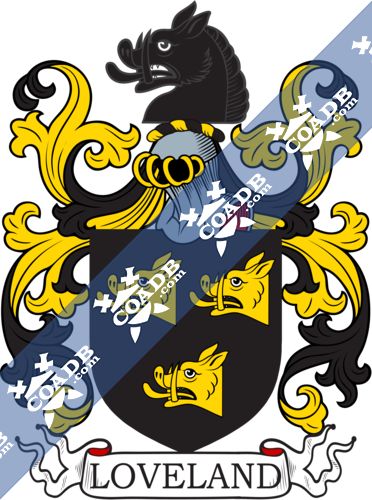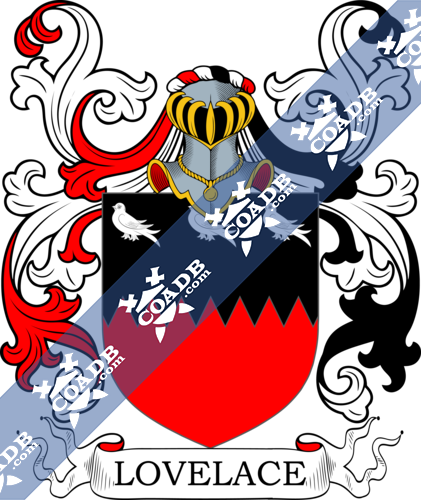Loveland Family Crest, Coat of Arms and Name History

Loveland Coat of Arms Gallery
Don’t know which Coat of Arms is yours?
We can do a genealogical research. Find out the exact history of your family!
Learn MoreLoveland Origin:
England
Origins of Loveland:
The origin of this unique surname evolved originally from England and is a locational name from various places in England. It derived from now a misplaced medieval village called Loveland nearby the ruler of Reigate in the province of Surrey. It is believed that in the 18th century, this village whose name perhaps derived from the start of 7th century owned name “Loaf,” was perhaps declined if not completely removed, by what was recognized as “emparking.” Some more than three thousand surnames of the British Isles are known to have derived from “misplaced” communities, although most declined not by emparking. Rather from the need to change the land use from farmable to the field for animals, to boost the fabric business by sheep grazing. Other different reasons, were the great diseases that widespread which removed the country between the centuries respectively 15th and 17th, often decreasing portions by a third and making many villages uncommercial. When this problem occurred people migrated to the large towns especially London, where unusually this name is not well listed.
Variations:
More common variations of Loveland are: Louveland, Lovelandy, Lovueland, Lovelande, Lovelandi, Lovland, Lovelund, Leveland, Lovelind, Lovelandd.
England:
The early origins of the surname Loveland were in Glamorganshire (Welsh: Sir Forgannwg), a part of South Wales, and an early component of the Welsh State of Glywysing, where people made a family seat from very early times. Some say before the success of Norman and the entrance of Duke William at Hastings in 1066 A.D.
The very first recording spelling of the family was shown to be that of Ann Loveland, the daughter of Christian Loveland, named at Sunbury on the Thames, on October 15 1604. On May 17 1659, Dorothie Loveland, married Thomas Russon at St Peters Church, Pauls Wharf, in the land of London.
United States:
People with the Loveland surname also settled in the United States beginning in the 17 century. Individuals who settled in the 17th Century included Robert Loveland who landed in Massachusetts in the year 1645.
People with the Loveland surname, who came in the 18th century included John Loveland, who came to Virginia in the year 1705
People with the Loveland surname who arrived in the 19th century include Charles Stephen Loveland, who came to Colorado in the year 1820.
Australia:
Some of the Loveland individuals who settled ultimately in Australia in the 19th century included Edward Loveland, aged 26, Edward Loveland, a servant and Esther Loveland, aged 27, arrived in Adelaide, Australia aboard the ship “British Empire” in the year 1850.
Here is the population distribution of the last name Loveland: United States 6,980; England 688; Australia 217; Canada 98; South Africa 274; Wales 90; New Zealand 26; Scotland 33; Norway 20; Spain 7;
Notable People:
Albert J. Loveland (1893-1961), served as Under-Secretary of farming, which is now recognized as another title – United States Deputy Secretary of Agriculture, under the guidelines of Harry S. Truman. He was selected to the important post by Truman in the year 1948 and gave services until March 1950, to serve in Congress. A supporter of the Democratic Party, Loveland went up against, albeit unsuccessfully, Republican Bourke Blakemore Hickenlooper for a seat in the U.S. Senate in 1950.
Donald W. Loveland (1934) was born in Rochester; New York and is a retired teacher of computer science at Duke University.
Ian Loveland (1983) is a famous mixed military arts fighter.
Ralph A. Loveland (1819 – 1899) was a New York politician, and later became a Michigan lumberjack or trimmer. He played a significant role in U.S. politics.
William Austin Hamilton Loveland (1826) was an American railroad manager and an entrepreneur at the end of the 19th century. An early citizen of Golden city when it was still just a part of the Colorado Territory. He was the famous producer of the Colorado Central Railroad and the major figure in the early history of Colorado.
Blazons & Genealogy Notes
(co. Norfolk). Sable three boars’ heads couped or. Crest—A boar’s head and neck couped sable.







